12 Types of Companion Plants for Coneflowers (Echinacea)
-
Pete Ortiz
- Last updated:

Busy gardeners can appreciate a low-maintenance perennial like coneflowers. When you’re fussing over more finicky plants, these hardy herbs deliver reliably gorgeous blooms in the flower garden every summer.
But an easy-going attitude and vibrant colors aren’t the only benefits of bringing coneflowers into your landscaping scheme. These charming native plants attract live beauty throughout the year. Colorful butterflies, bees, and hummingbirds fill the garden, while fall seed production draws various birds to the yard.
By bringing in plant-helping pollinators, coneflowers will make more than the average gardener fall in love with them. Plenty of plants, from flowers to vegetables, like having coneflowers around to help them thrive. Let’s look at some of the more common companion plants for coneflowers to gain some perspective on practical pairings.
The 12 Types of Companion Plants for Coneflowers (Echinacea)
1. Gaillardia
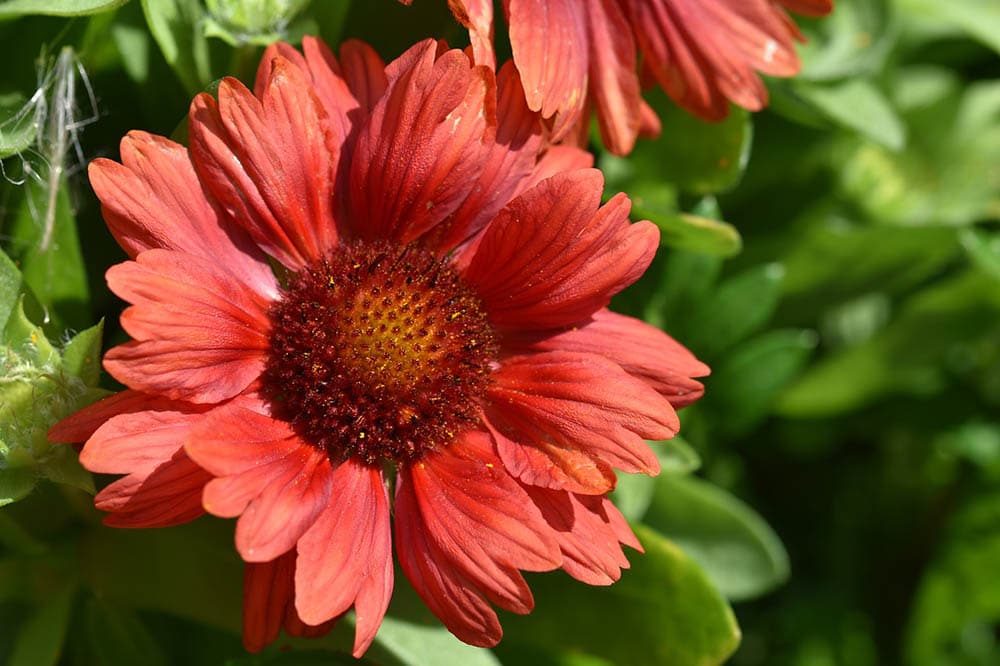
| Hardiness Zone: | 3–9 |
| Height: | 12–36 inches |
| Soil and Sun: | Moist, well-drained soil; Full sun |
Gaillardia will enhance any effort to attract more pollinators, and the typically low height of 12–18 inches provides a perfect juxtaposition against taller flowers. The short-lived perennial makes a lovely cut flower, attracts few diseases and pests, and has soil tolerances similar to coneflowers.
2. Hardy Geranium

| Hardiness Zone: | 3–9 |
| Height: | 6–36 inches |
| Soil and Sun: | Moist, well-drained soil; Full/partial sun |
Hardy geraniums, or cranesbill geraniums, are available in assorted shades, shapes, and sizes to suit any flower garden. The one-inch cup-shaped flowers appear in various white, blue, purple, and pink hues. Most varieties are low-lying, making excellent ground covers to complement your coneflowers.
Depending on the variety, hardy geraniums may need moderately rich soil to thrive. In general, full or partial sun and dry soil conditions work for geraniums. The long-lasting flowers can bloom from late spring to early fall. Complex and equally intriguing foliage, ranging in color from green to bronze, adds a lush accent to the geranium flowers and neighboring coneflowers.
3. Goldenrod
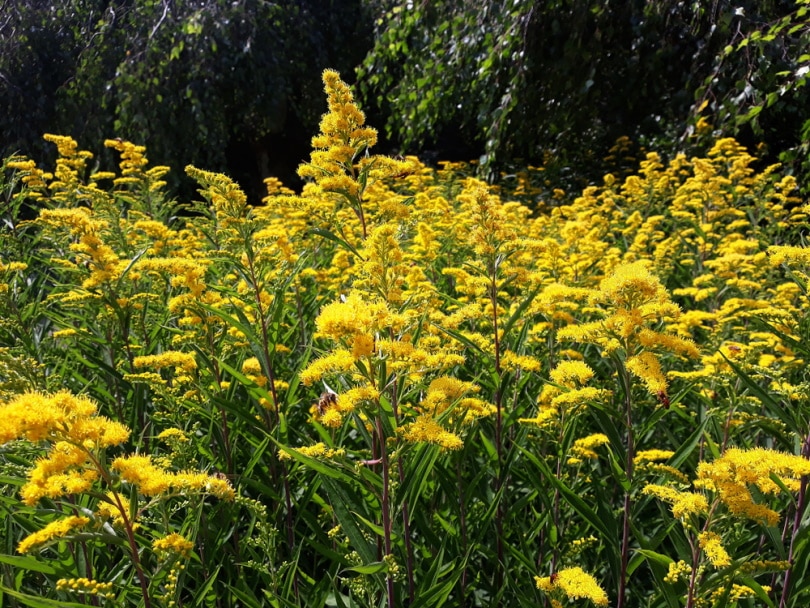
| Hardiness Zone: | 4–9 |
| Height: | 36–48 inches |
| Soil and Sun: | Well-drained soil; Full sun |
Like coneflowers and other native wildflowers, goldenrod is a carefree grower. It doesn’t require fertilizing in most cases, and given its drought tolerance and pest resistance, it’s almost maintenance-free! Give them full sun and good air circulation to prevent the few diseases they may suffer, which shouldn’t be challenging if you’re planting them with coneflowers.
Goldenrod can grow up to 6 feet tall, depending on the variety, but you can also cut them down to inspire bushier growth and more flowering. The clumping perennials make a stunning companion plant for coneflowers when they blossom together. Plant them with a late-blooming, deep purple coneflower variety to create vibrant contrasts of colors, textures, and forms.
4. Sedum

| Hardiness Zone: | 3–10 |
| Height: | 4–36 inches |
| Soil and Sun: | Sandy, well-drained; Full sun |
With robust pink blooms atop glistening succulent stalks, sedum plants are attractive from every angle. Flat-topped clusters of small, star-shaped flowers in colors ranging from yellow to magenta appear in late summer. The fleshy paddle-like leaves come in various shades and variegated patterns, supplying garden interest deep into the fall.
Between its foliage and flowering, sedum makes an ideal companion plant for coneflowers from an aesthetic standpoint. The tough, pollinator-friendly perennial doesn’t need much more than adequate drainage, making it appropriate for poor soils that accommodate coneflowers.
5. Catmint
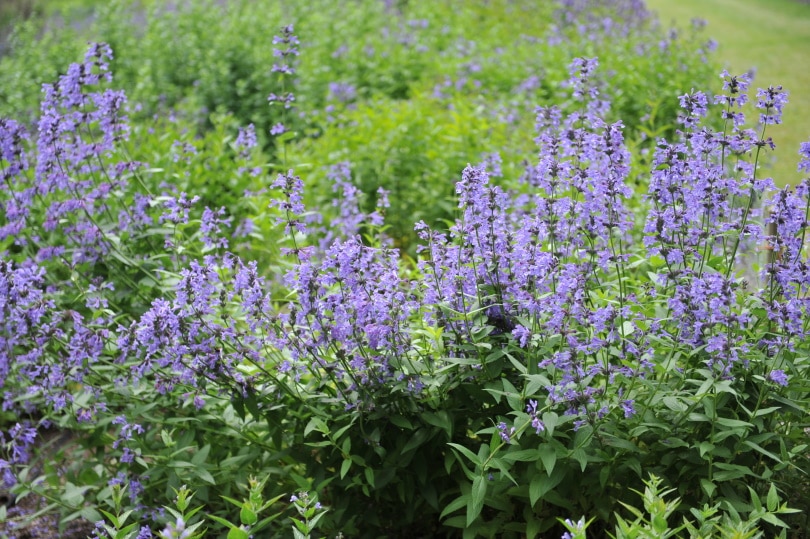
| Hardiness Zone: | 3–8 |
| Height: | 9–36 inches |
| Soil and Sun: | Moist, well-drained; Full sun |
Coneflowers resist numerous nuisances, but they appreciate help from companion plants for particular pest problems. Mint is an effective deterrent for many would-be coneflower attackers, including aphids, white flies, and Japanese beetles. Although they’re relatively deer-resistant in maturity, young coneflowers can fall victim to deer, rabbits, and other nibblers. With catmint, you’ll give them a better chance of survival.
Catmint is a more attractive, less cat-intoxicating relative of catnip, producing brilliant stalks of lavender, pink, or white flowers from spring through fall. Grow this drought-tolerant plant as a filler in ornamental gardens, but be cautious with its easy-spreading nature. As a feature in front of coneflowers, catmint serves as a protector and an aide to highlight the taller Echinacea.
6. Coral Bells
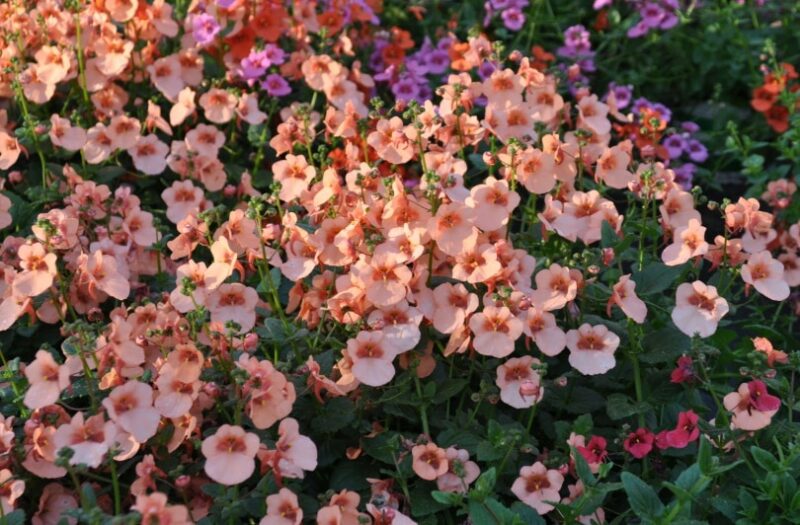
| Hardiness Zone: | 4–9 |
| Height: | 12–36 inches |
| Soil and Sun: | Rich, moist, well-drained; Full/partial sun |
Heucheras, or coral bells, are native perennial herbs that show off with massive, colorful cascades of foliage. Forming in foot-tall mounds, coral bells grow evergreen or semi-evergreen leaves in broad spectrums of forms, patterns, and colors. Leaves may be ruffled or smooth, appearing in rich purple, burgundy, lime green, silver, or gold hues.
Coral bells have slightly different preferences than coneflowers, but their high tolerance for diversity makes them no less easy to grow. They work well as a striking ground cover or rock garden element. Undersized bell-shaped flowers attract early pollinators in spring to early summer, providing added interest to the landscaping without stealing the show from later-blooming Echinacea.
7. Black-Eyed Susan
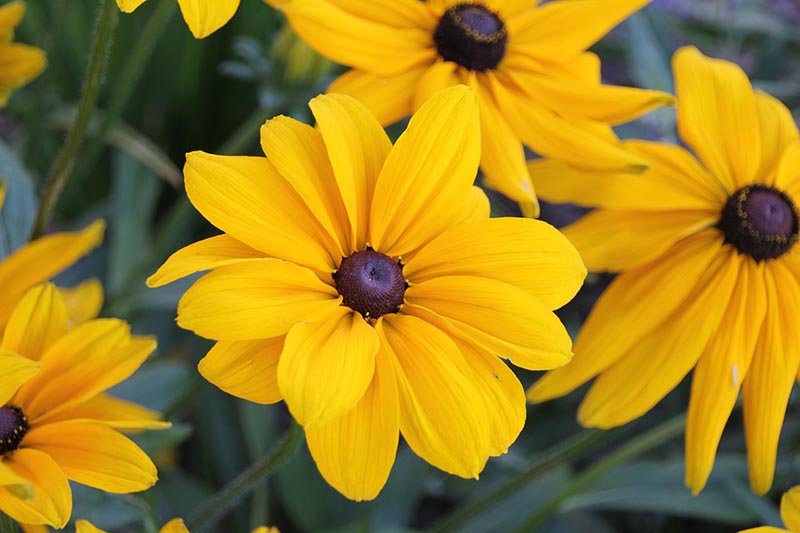
| Hardiness Zone: | 3–9 |
| Height: | 12–36 inches |
| Soil and Sun: | Rich, moist, well-drained; Full sun |
Black-eyed Susans are one of the most identifiable American wildflowers, and they are a traditional native garden feature offering fun versatility with the relatively similar coneflower. They grow to equal heights and develop rayed flowers with overlapping blooming periods. But with a golden-yellow vibrance, the black-eyed Susan creates a spectacular contrast against the purple and blue coneflowers.
While coneflowers and black-eyed Susans have slightly different soil and sun preferences, they’re forgiving enough to work alongside each other in several settings, including borders, pollinator gardens, and containers. Mix them together or grow one neatly behind the other for unique color arrangements.
8. Bee Balm

| Hardiness Zone: | 3–9 |
| Height: | 24–48 inches |
| Soil and Sun: | Moist, well-drained; Full sun |
Bee balm plants bloom like bursting fireworks in white, red, purple, or pink hues. But unlike a 4th of July display, the narrow, tubular flowers shine their brightest in the light of day. Bee balm wants to bask in full sun and rich soil, where vigorous growth will provide pleasing fragrances, rich landscaping colors, and a wealth of pollinators.
Like many mint family members, bee balm offers herbal infusions in the kitchen and potentially uncontrolled growth in the garden. With edging and attention, these otherwise low-maintenance plants can make a wonderful companion for clump-forming coneflowers. Traditional bee balm can outgrow coneflowers, but dwarf varieties growing up to 18 inches can also complement Echinacea in cutting gardens and borders.
9. Butterfly Weed
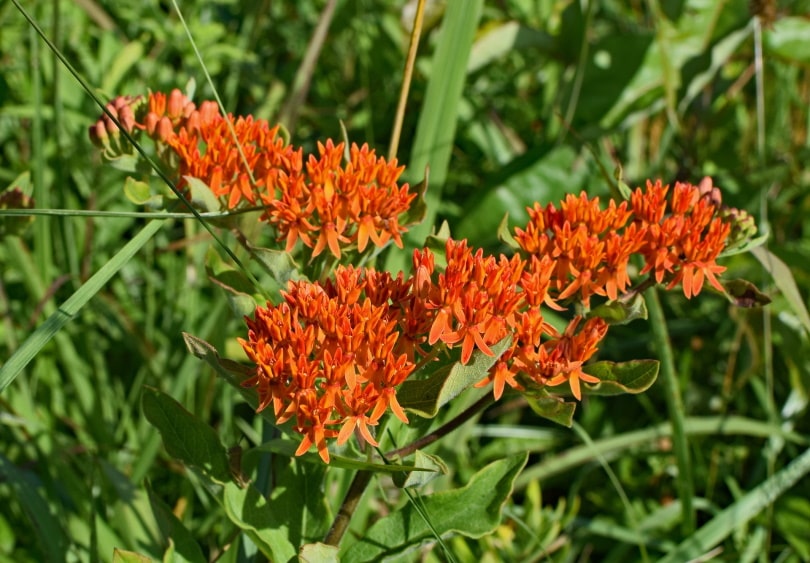
| Hardiness Zone: | 3–9 |
| Height: | 12–24 inches |
| Soil and Sun: | Dry, well-drained; Full sun |
If you live in a drier climate, butterfly weed should be one of the first companion plants to consider for coneflowers. Though they take a few years to emerge, you’ll enjoy a reward of flat-topped, bright orange-yellow flowers in early to late summer to complement your blooming coneflowers.
Butterfly weed needs little water, fertilizer, or general care, but aphids are a common issue that can also damage your coneflowers. But because they attract beneficial pollinators, including monarch butterflies, avoiding chemical pest control is crucial. Instead, consider adding repellent plants like catmint. Any added blue or purple flower will make butterfly weed even more striking in the garden.
10. Lavender
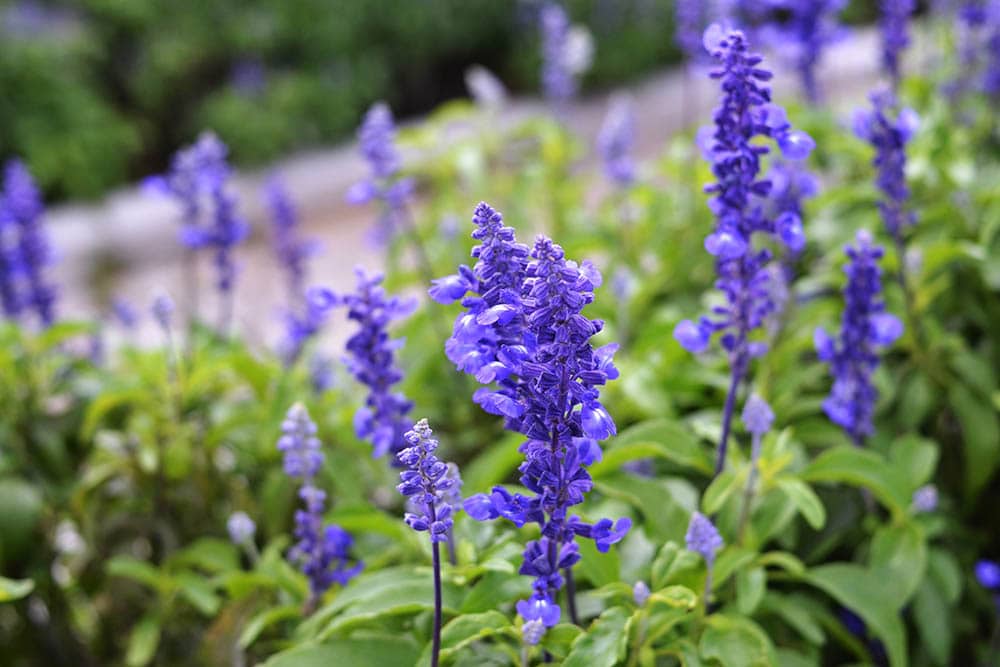
| Hardiness Zone: | 5–9 |
| Height: | 20–24 inches |
| Soil and Sun: | Well-drained soil; Full sun |
The non-native lavender plant isn’t as hardened to North America’s diverse climates as many other wildflowers. As a Mediterranean herb, it enjoys warmer regions, though you can find some more cold-hardy varieties, such as English lavender, to bring the classic fragrance to gardens in zones 4 and 5. Another low-maintenance wonder, lavender does well with little water and fertilizer.
Lavender’s peak bloom time is in mid-summer, but you can also find early blooming varieties if you don’t want the striking purple hues to steal the show from their companion coneflowers. Plant them among drought-tolerant herbs to let the bright gray-green foliage enhance the other colors. Position lavender strategically around patios and mixed gardens to take advantage of its pest and deer-deterrent aroma.
11. Gayfeather
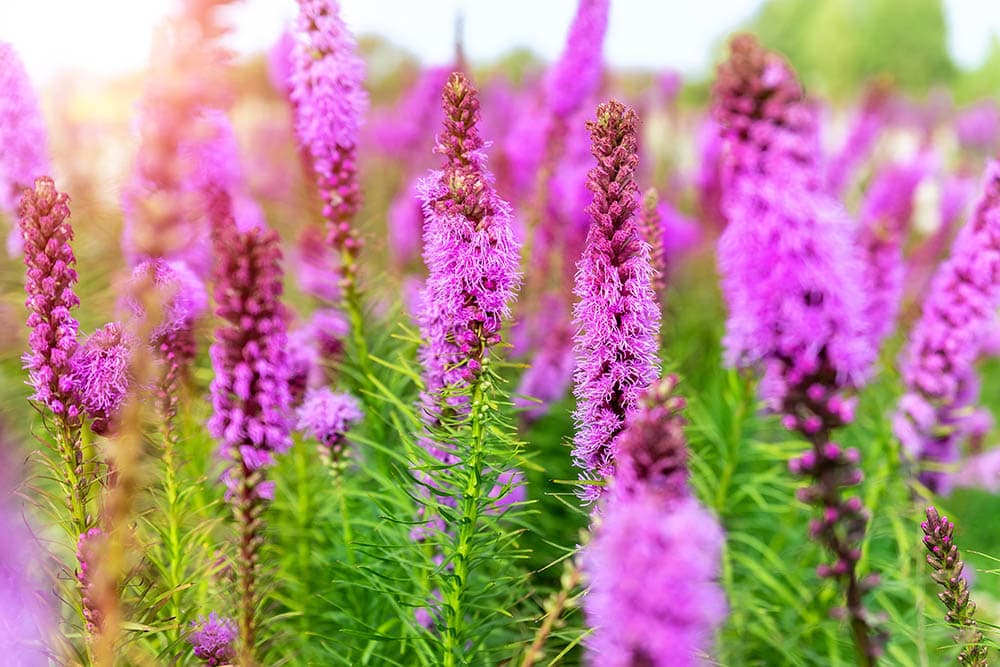
| Hardiness Zone: | 3–10 |
| Height: | 24–48 inches |
| Soil and Sun: | Moist, well-drained soil; Full sun |
Gayfeather is a native wildflower that thrives in full sun and slightly dry soil. In borders and cottage gardens, the prairie perennials help bring in butterflies and hummingbirds while resisting deer, making them relatively worry-free.
Though Gayfeather plants may be easy to grow, they work hard to grab your attention. Also called blazing star, the plant grows sturdy, prominent spikes of tightly packed purple flowers. Meanwhile, the grass-like leaves offer an appealing contrast during the mid-summer blooming period, turning a delightful bronze in the fall to supply ongoing interest.
12. Yarrow
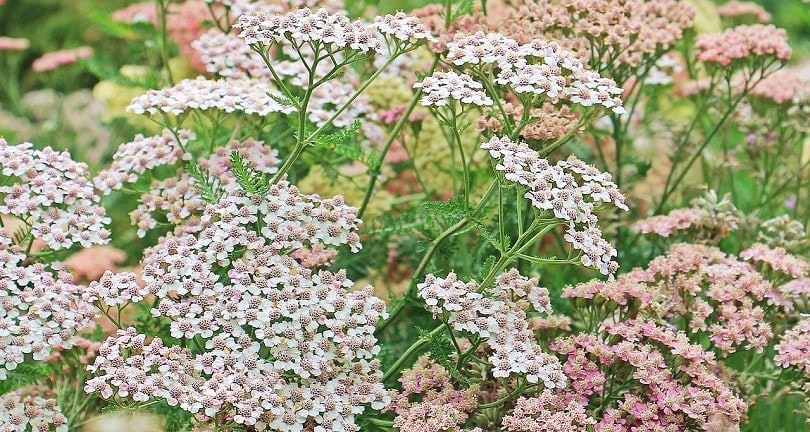
| Hardiness Zone: | 3–9 |
| Height: | 24–48 inches |
| Soil and Sun: | Well-drained soil; Full sun |
Subtle and delicate, yarrow is a garden-brightening filler that allows coneflowers to take center stage. Tons of tiny blooms emerge in abundant clusters amid long, narrow stems and fern-like foliage during early to late summer.
Yarrow thrives in dry conditions like other native wildflowers. It appreciates rich soil to give it a head start, but you shouldn’t see any issues with its spread if your other plants need poorer soil. It may need extra attention due to its tendency to spread and crowd out competition. But in a cutting garden, it adds a perfect complement and excellent pest resistance.
Coneflower & Vegetable Companion Planting
As an essential lure for numerous beneficial bugs during the summer, coneflowers can help your pollinator-dependent veggies thrive. Their tolerance for a vast range of soil types means you can plant them in rich, moist soil alongside garden favorites like cabbage, broccoli, and eggplant. Bees and butterflies will ensure abundant growth, and predatory insects like ladybugs will keep losses to a minimum.
Worst Companion Plants for Coneflowers
From ornamental grasses to crisp garden veggies, countless plants can benefit from nearby coneflowers. The deep taproot and clumping growth mean coneflowers can pull moisture in dry soil and won’t encroach on other plants.
The primary consideration is the coneflowers themselves. Though tolerant of most growing conditions, they prefer full sun and neutral pH soil. Acid-loving fruit plants like blueberries may benefit from the extra pollination, but your coneflowers won’t see the best growth. Meanwhile, nearby trees could block the sun for extended periods, leading to poor flower growth.
Conclusion
An easy-going wildflower or cottage garden wouldn’t be complete without the unmistakable shuttlecock forms of the native coneflower. Standing tall and proud, the coneflower offers vivid summertime hues while helping the entire garden thrive. It’s never a challenge to find suitable companion plants for coneflowers, and with these perspectives, you’ll always make the most of having them in your backyard.
Featured Image Credit: robbihoy, Pixabay
Contents


